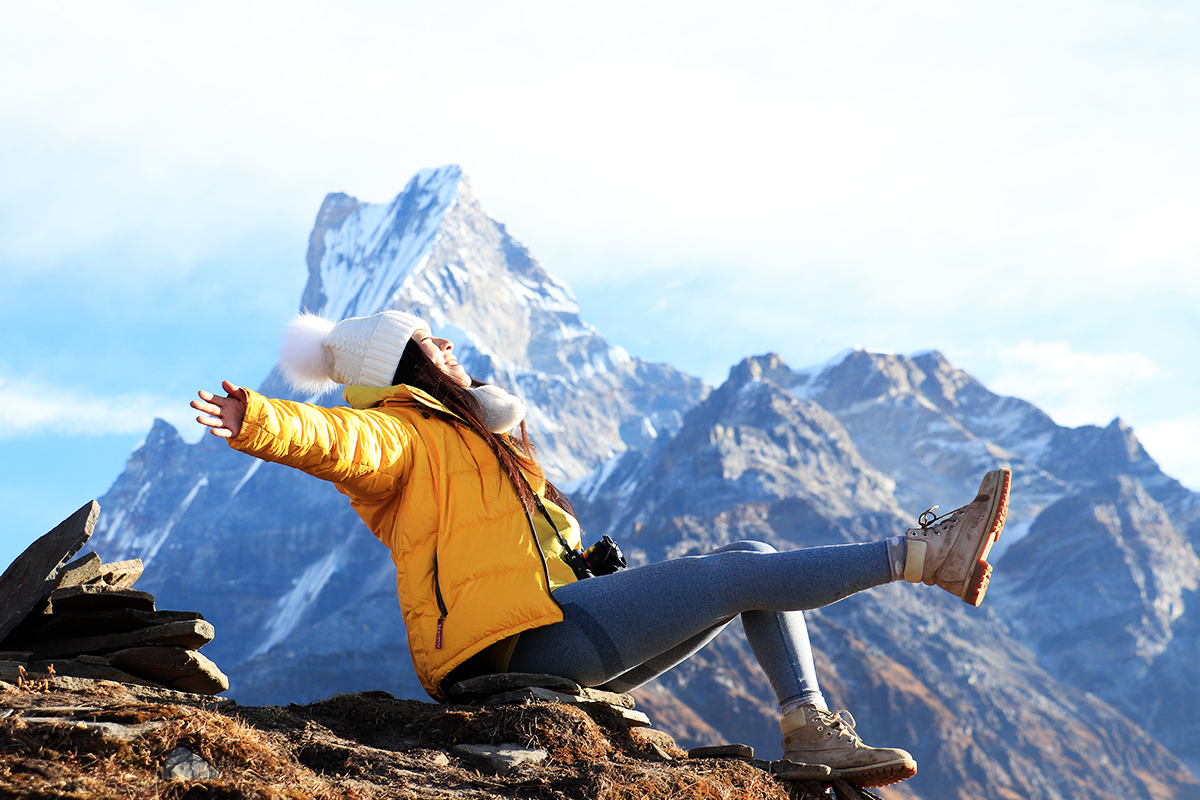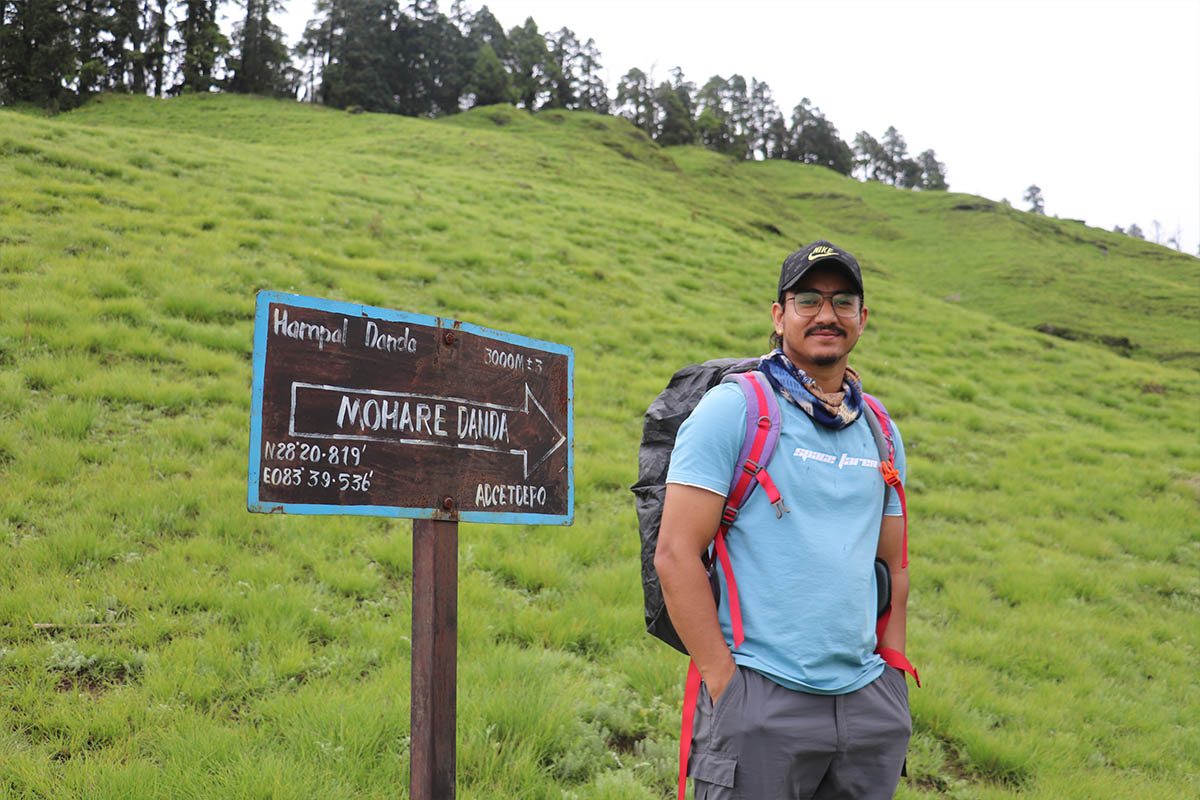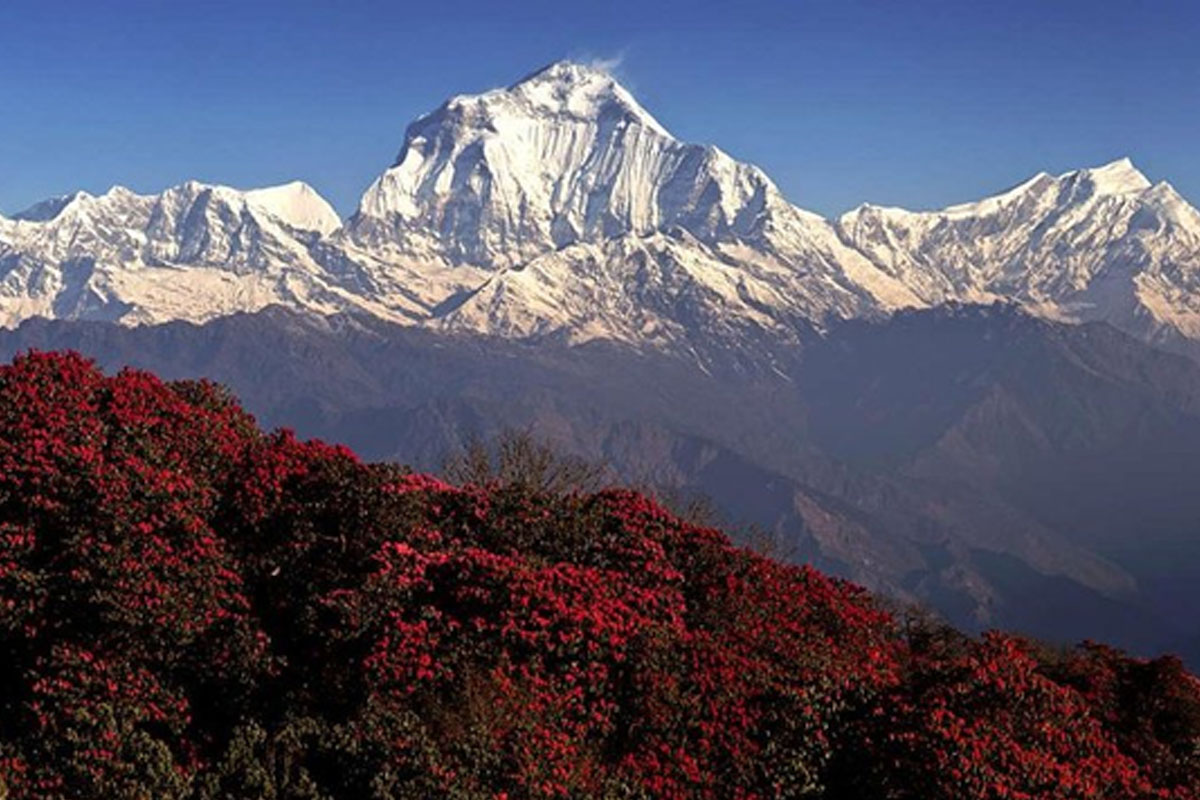Why Choose Alternative Trekking Routes in the Annapurna Region
The Annapurna Base Camp and Annapurna Circuit treks are becoming increasingly popular and crowded, despite other trails being equally beautiful and rich in culture. There are plenty of lesser-known routes in the Annapurna region that take you through isolated villages and farmland, forests and ridgelines, and alpine meadows. These trails are known for unobstructed views of a variety of peaks, including Mt.Dhaulagiri, Annapurna South, Machhapuchhre, and Hiunchuli. Most of these trails involve local communities and are eco-managed for a sustainable trekking experience.
The routes are flexible for everyone, from beginners, families, to highly-skilled trekkers. You can pursue shorter treks within the Annapurna region or combine different routes together and explore the region at your own pace.
By choosing off-the-beaten-path trekking paths in the Annapurna region, trekkers can still have a peaceful hiking experience and true interactions with the local community while experiencing some of the iconic mountain views of the region.
Top Alternative Treks Beyond Annapurna Base Camp and Annapurna Circuit
Mardi Himal Trek
Trip facts of the Mardi Himal trek
- Total Duration: 8-9 days (with acclimatization days included)
- Total Distance: Approximately 72 kilometers (round trip)
- Difficulty Level: Moderate
- Max. Elevation: 4,500 meters at Mardi Himal Base Camp
The Mardi Himal Trek is a shorter and comparatively less crowded hiking route in Nepal's eastern Annapurna region, which is often viewed as one of the best alternative treks to Annapurna Base Camp and Annapurna Circuit. The Mardi Himal trek offers proximate views of popular peaks, including Machhapuchhre (Fishtail), Annapurna South, and Hiunchuli. The trek follows a trail that slowly ascends through canopied forests, traditional villages, and alpine terrain to reach Mardi Himal Base Camp at approximately 4,500 meters.

The trek usually begins from Kande or Phedi, following a well-established route through rest stops, like Australian Camp, Forest Camp, Low Camp, High Camp, and ultimately Mardi Himal Base Camp. The path is well-organized, with small teahouses along the way that provide good food and accommodation.
It allows trekkers to explore the Annapurna region without the overwhelming crowds and foot traffic common on other popular trekking routes. There is also flexibility in the itinerary, and the Mardi Himal route is linked with some of the shorter nearby treks, like Ghandruk or Dhampus, for those who wish to extend their journey and explore more of the region. This trek is suitable for hikers with average fitness levels and does not require prior experience at high altitude.
Khopra Ridge Trek
Trip facts of the Khopra Ridge trek
- Total Duration: 7-9 days ( With acclimatization days)
- Total Distance: Approximately 65 kilometers (round trip)
- Difficulty Level: Moderate
- Max. Elevation: 3,660 meters at Khopra Ridge
The Khopra Ridge Trek is a serene and rewarding alternative trek in the Annapurna region of Nepal. Unlike the more traveled trails, this trek allows for exploration of remote villages, dense forests, and terraced farmland with amazing views of the most well-known mountains in the world, including Dhaulagiri (8,167 m), Annapurna South (7,219 m), Nilgiri (7,061 m), Machhapuchhre (6,993 m), and Hiunchuli (6,441 m). The trail leads to Khopra Ridge at approximately 3,660 meters, and for trekkers seeking more challenging sides of the trek, this route to the holy Khayar Lake (4,600 meters) can be added.

Khopra trek usually begins from Nayapul or Ghandruk, following a route that crosses Tadapani, Dobato, and Chistibung. During the trek, basic food and lodging are available in teahouses, owned and operated by the local community. This provides trekkers with an authentic experience while also being able to support the livelihoods of community members.
The trek, which takes about 7 to 9 days, can be classified as moderately difficult in terms of trekking, although it is rewarding in terms of views and cultural experiences. Khopra Ridge is a perfect destination for trekkers who want a less-traveled route in the Annapurna region while being able to experience iconic Himalayan views.
The Khopra Ridge Trek is a serene and fulfilling option to the better-traveled routes within Annapurna, making it ideal for trekkers looking for Annapurna region alternative treks.
Tilicho Lake Trek
Trip facts of Tilicho Lake trek
- Total Duration: 7- 9 days
- Total Distance: Approximately 120 kilometers (round trip)
- Difficulty Level: Moderate to strenuous
- Max. Elevation: 4,919 meters at Tilicho Lake
Situated in the Northern Annapurna region, the Tilicho Lake Trek is one of the most scenic alternatives to the Annapurna circuit and a great option for those interested in trekking in the Annapurna region. It takes trekkers to Tilicho Lake (4,919 m), one of the world's highest lakes, which sits at the base of Tilicho Peak (7,134 m). The Tilicho Lake trek is a mesmerizing journey through beautiful mountain scenery, including views of Annapurna II (7,937 m), Annapurna III (7,555 m), Gangapurna (7,455 m), and Dhaulagiri (8,167 m) among others in the distance.

The trek usually begins in Manang, following a section of the Annapurna Circuit before departing for Tilicho Base Camp and the lake. Trekkers will pass through the traditional villages, beautiful alpine meadows, and rugged mountain landscape, all while experiencing the amazing beauty of nature and villages. Teahouses along the route offer good accommodation and meals, making the trek accessible without camping.
Alternatively, trekkers can reach Tilicho Lake from Jomsom via the Mesokanto La Pass, a more challenging and remote route that offers breathtaking views and a sense of adventure for experienced hikers.
The Tilicho Lake Trek usually takes about 7 to 10 days to complete and can be done as an independent trip or combined with the Annapurna Circuit. It is ideal for trekkers looking for treks to do beside Annapurna Base Camp and Annapurna Circuit, offering high-altitude adventure, unique landscapes, and peaceful surroundings away from the busier trails.
Mohare Danda Trek
Trip facts of the Mohare Danda trek
- Total Duration: 7- 8 days
- Total Distance: Approximately 55 kilometers (round trip)
- Difficulty Level: Easy to Moderate
- Max. Elevation: 3,300 meters at Mohare Danda
The Mohare Danda Trek is located in the southwestern area of the Annapurna region, and is considered one of the best treks besides the Annapurna Base Camp and Annapurna Circuit. It is situated on a ridge between the Annapurna and Dhaulagiri ranges, providing breathtaking views of Dhaulagiri (8,167 m), Annapurna South (7,219 m), Nilgiri, Hiunchuli, Gangapurna, and Machhapuchhre (6,993 m), making it a great spot for sunrise and sunset views.

This remote community-based trekking trail passes through Magar and Gurung villages and dense rhododendron forests; therefore, it is one of the most authentic experiences in the Annapurna region. In addition, local lodges run by villagers support eco-tourism and the development of the community.
The Mohare Danda Trek is an easy-to-moderate trek that takes around 7-8 days, and is great for trekkers looking for quiet trails and cultural experiences. Being one of the less crowded trails in the Annapurna region, you will experience incredible views with local hospitality in a short, rewarding trek.
Ghorepani Poonhill Trek
Trip facts of Ghorepani Poonhill trek
- Total Duration: 4-5 days
- Total Distance: Approximately 42 kilometers (round trip)
- Difficulty Level: Easy to Moderate
- Max. Elevation: 3,210 meters at Poonhill
The Ghorepani Poonhill Trek is the most popular short trek in the Annapurna region. It is a good option for treks to do besides the Annapurna Circuit and Annapurna Base Camp (ABC). The trekking trail is known for its accessibility, easy-to-moderate level, and stunning mountain views. From Poonhill (3,210 m), trekkers can see a panoramic view of Dhaulagiri (8,167 m), Annapurna South (7,219 m), Machhapuchhre (6,993 m), Hiunchuli (6,441 m), and Nilgiri (7,061 m), especially during sunrises.

The trek usually starts from Nayapul or Tikhedhunga, where trekkers travel to Ulleri, then Ghorepani, before Poonhill. The hiking route goes through terraced farmlands, rhododendron forests, and modest Gurung and Magar villages, allowing trekkers to see both a natural and cultural experience.
This trek can be completed in about 4 to 5 days and is great for beginners, families, with limited time. It is one of the more scenic and accessible trails in the Annapurna region that provides mountain views and local hospitality in a short timeframe.
Nar Phu Valley Trek
Trip facts of Nar Phu Valley trek
- Total Duration: 11-14 days
- Total Distance: Approximately 130 kilometers (round trip)
- Difficulty Level: Easy to Moderate
- Max. Elevation: 5320 meters at Kangla Pass
The Nar Phu Valley Trek is one of the most extraordinary and secluded unknown trekking routes in the Annapurna region, showing trekkers a true cultural and natural experience. Located on the northeast part of the Annapurna Conservation Area, the trek takes trekkers into the hidden valleys of Nar and Phu, which are close to the Tibetan border. It crosses rugged trails, centuries-old monasteries, and stone villages that still preserve a Tibetan way of life.

This trek is perfect for trekkers who are looking for off-the-beaten-path trails in the Annapurna region, as it remains significantly quieter than other trekking routes. The trek offers magnificent views of Annapurna II (7,937 m), Gangapurna (7,455 m), Tilicho Peak (7,134 m), and Lamjung Himal (6,983 m) while crossing high mountain passes such as the Kang La Pass (5,320 m).
The trek generally starts from Koto (close to Chame) and lasts about 10 to 14 days. This trek is especially great for a more experienced trekker looking for a hidden and rugged adventure trek while being able to experience authentic Himalayan culture. The Nar Phu Valley trek is a rare experience to trek in an incredibly remote and traditional area of the Annapurna region that offers an excellent opportunity for those looking for quieter trekking routes in the Annapurna region beyond the established wild trekking trails.
Panchase Trek
Trip facts of the Panchase trek
- Total Duration: 3-5 days
- Total Distance: Approximately 45 kilometers (round trip)
- Difficulty Level: Easy to Moderate
- Max. Elevation: 2,500 meters at Panchase Hill
The Panchase Trek is a lesser-known trek in the western part of the Annapurna region and is a wonderful alternative for those seeking an alternative trekking route in Annapurna. The trek starts from Pokhara and passes through forested hills, terraced farmlands, and traditional villages before reaching Panchase Hill (2,500 m). From the top, trekkers enjoy panoramic views of Annapurna South (7,219 m), Machhapuchhre (6,993 m), Dhaulagiri (8,167 m), and Lamjung Himal (6,983 m).

Since this trek follows a less-traveled route, it is a peaceful hiking option. Here, trekkers can visit small Gurung and Brahmin villages to see authentic local culture and life. The trek does not have the crowds like other popular routes.
The Panchase Trek is also good for beginners and families. In fact, the trek is generally completed in three to five days, making it one of the better short treks in the Annapurna region. The trek is a bit easier and is exhilarating for what it offers in terms of views of the mountains, offering trekkers a more peaceful experience in the Himalayan region.
Conclusion
The Annapurna area has a variety of trekking options that are overlooked, in addition to the busy Annapurna Base Camp and Annapurna Circuit. Trekking options such as Mardi Himal, Khopra Ridge, Tilicho Lake, Mohare Danda, Ghorepani Poonhill, Nar Phu Valley, and Panchase have less-travelled and less-busy trails, all providing stunning mountain scenery, remote valleys, and beautiful villages. These treks allow trekkers the opportunity to admire rhododendron forests, alpine meadows, terraced farmlands, and remote villages, while also enabling them to meet and support local communities in eco-friendly lodges.
These lesser-used trekking options in the Annapurna area are beginner-friendly or, suitable for families, or even for the more-experienced trekker, who are looking for shorter treks in the Annapurna area or speaking to more extensive Himalayan adventures. If you are willing to trek in the less-known areas of the Annapurna area, you can still trek in peaceful locations while enjoying the same stunning views and learning from the rich local culture without the throngs of trekkers, and as a result being a good alternative to trekking ABC and ACT trails.
Frequently Asked Questions
What is the best season for trekking on the lesser-known Annapurna trails?
Unlike any other trekking trails, the best time to visit the lesser-known Annapurna trails is during the spring (March to May) and autumn seasons (September to November). These months are known for good visibility and stable weather, and great views of the mountains. Spring also brings blooming rhododendrons, and autumn provides crisp visibility and air. It is less favorable in the winter or during the monsoon periods due to snow, landslides, or rain.
Do I need a guide, or can I trek independently on these alternative routes?
Some trails can be navigated independently by well-experienced trekkers, but hiring a local guide is a wise option, especially for remote treks such as Nar Phu Valley or Tilicho Lake. Guides will aid in navigating, provide safety permits, and provide local culture information.
What kind of accommodation is available on these less crowded trails?
Most alternative trails have lodges or teahouses run by local communities. These teahouses will have basic meals, beds, and a warm space to rest. In some remote locations, trekkers may need to carry sleeping bags or mats. Staying in teahouses supports the local community.
Can these treks be combined with popular routes like ABC or the Annapurna Circuit?
Yes, many alternative trails can be combined with routes that are sections of Annapurna Circuit or ABC. For example, the Tilicho Lake Trek can join with Annapurna Circuit, and Mardi Himal can connect with either Ghandruk or Dhampus.
How can trekkers prepare for high-altitude trekking on lesser-known routes?
Preparation should consist of cardiovascular exercise, strength training, and practice hikes carrying a backpack. Trip members should acclimatize gradually, drink plenty of water, and be aware of the symptoms of altitude sickness, which is especially important when traveling on trails that exceed 4,500 meters.
Which treks are best for photography and scenic viewpoints in Annapurna?
Trails like Khopra Ridge, Mardi Himal, Tilicho Lake, Mohare Danda, and Panchase are perfect for photography. These treks offer sweeping ridges, alpine lakes, rhododendron forests, and beautiful places to view the sunrise and sunset.

.jpg)







